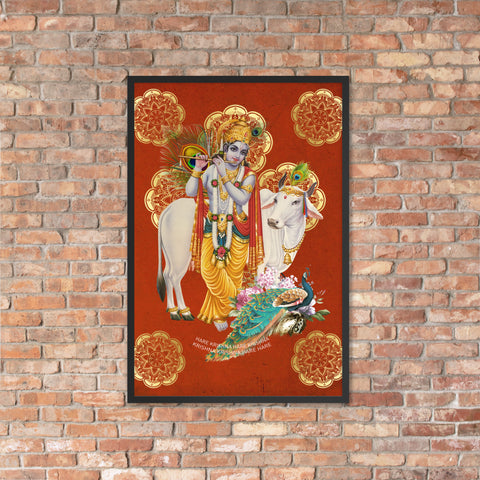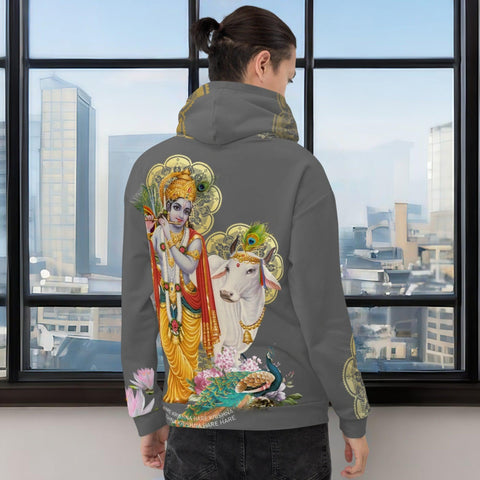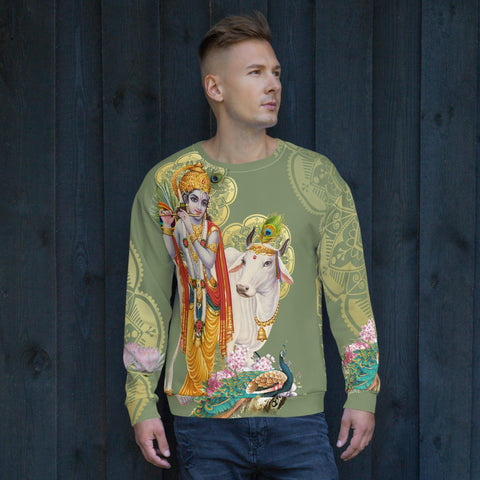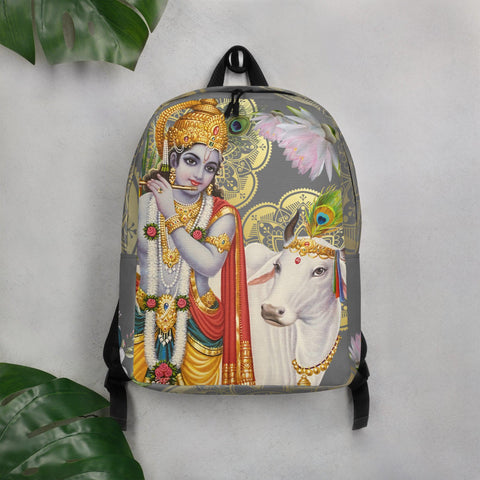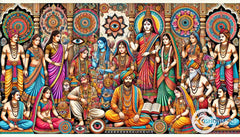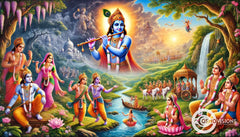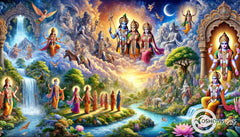Gopis Love for Krishna: Exploring the Divine Life of Lord Krishna
Posted by Massimiliano Geraci
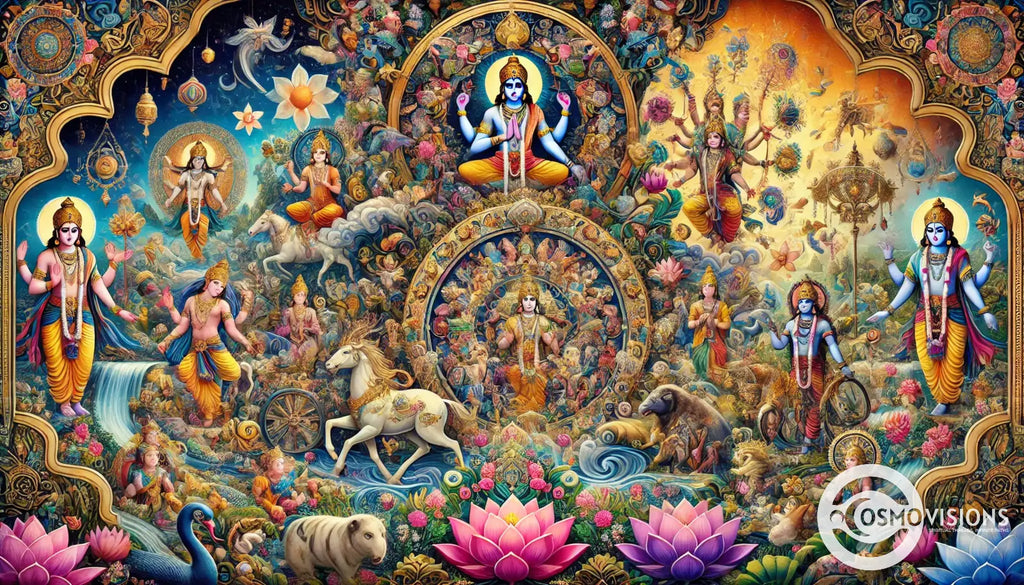
Exploring the divine love story between Krishna and the Gopis takes us deep into the heart of spiritual devotion and mythological enchantment. Many people find themselves drawn to these tales, yet struggle to grasp their deeper meanings or how they apply to modern life.
At the core of this narrative is a profound exploration of divine love, one point of transcending ordinary understanding and offering insights into eternal truths.
One captivating aspect is the Raas Lila, where Lord Krishna danced with the Gopis in Vrindavan, an event that symbolizes pure spiritual bliss and union with the Divine. This blog post aims to shed light on this celestial love story, illustrating how it exemplifies transcendental devotion beyond worldly desires.
By exploring this divine play (Leela), we uncover layers of metaphorical symbolism that speak directly to the soul's longing for unity with God.
Discover how Krishna's flute beckons not just the Gopis but all beings towards ultimate bliss. Explore further with us.
Who Are the Gopis in Krishna Lila?
Transitioning from an introduction to the enchanting stories of Lord Krishna's divine play, we now turn our focus to the gopis, central figures in Krishna Lila. The gopis are milkmaidens of Vrindavan, deeply revered for their unwavering devotion to Shri Krishna.
They represent the epitome of bhakti or divine love and serve as symbols of soulful dedication. In stories recounted in texts like the Srimad Bhagavata Purana, these devout women emerge as paramount devotees, illustrating a profound love that transcends worldly ties and expectations.
Their love for Krishna manifests through various leelas or divine plays, most notably the Raslila – a celestial dance where each gopi found herself dancing with one Gopi Krishna multiplied into his many forms.
This extraordinary event symbolizes the ultimate union of the devotee with divinity and also highlights themes such as self-surrender and pure devotion free from material desires. Through their actions, songs, and dances for Sri Krishna's pleasure alone, they exemplify how deep spiritual connection can lead to eternal bliss and liberation.
In the joyful chaos of Raslila danced purity itself; every step was a journey closer to supreme love.

What is the Role of the Gopis in Devotion?
The Gopis play a central role in devotion within the spiritual narratives surrounding Krishna, embodying pure, selfless love and total surrender to the Supreme Lord. As milk maidens in the pastoral settings of Vrindavan, they demonstrate an unparalleled passion towards Krishna, showcasing their willingness to leave all worldly duties for his sake.
Their actions illuminate the path of Bhakti yoga, where devotion transcends mere duty and becomes an expression of deep, eternal love for God. This journey is reminiscent of Gopi Krishna's life and his sudden and forceful awakening Kundalini awakening (evolutionary energy). Gopi Krishna's experience with awakened Kundalini through Kundalini Yoga demonstrates how devotion can lead to profound spiritual transformation within the human body. Kundalini was published in Great Britain and the United States and has since appeared in eleven major languages.
Through their interactions with Krishna—whether it be dancing in the divine Rasa Lila or yearning for his presence when he disappears—the Gopis exemplify how human devotion can reach a state of divine love (Madhurya Rasa).
This narrative is not just a tale from ancient texts; it serves as an enduring lesson on devotion's power to transform and elevate ordinary experiences into pathways to spiritual enlightenment.
Their story highlights that true devotion is characterized by unwavering faith and unconditional love towards Krishna, making them eternal symbols of Bhakti within Hinduism.
How Did the Gopis Show Their Love For Krishna?
Gopis left all their work, demonstrating an unparalleled devotion to Lord Krishna. Their actions transcended ordinary duties, aligning themselves with divine will. Through music and dance, particularly during the rasa dance by the Yamuna river, they immersed fully in Krishna's love.
This act of abandonment for divine adoration marked them as exemplary devotees within western world of Vaishnavism.
Krishna played his transcendental flute, and instantly, Gopis were struck with a profound spiritual awakening. They rushed towards the sound, disregarding societal norms and personal responsibilities.
In this spontaneous gathering around Krishna, they participated in raas lila — a celestial mystical experience, symbolizing the soul's eternal dance with the Divine. Through these acts of pure love and complete surrender to Krishna’s divine music on his transcendental flute, Gopis showcased an ideal model of bhakti (devotion).
Why Are the Gopis Considered Exemplary Devotees?
Transitioning from the profound ways in which the Gopis displayed their love for Krishna, we explore why their devotion is held in such high esteem. The Gopis' unwavering focus on Lord Krishna, transcending all worldly attachments and duties, showcases an unparalleled level of bhakti (devotion).
This intense adoration was not confined to mere admiration but was a manifestation of pure divine love that sought nothing in return.
Their love for Krishna eclipsed everything else—family responsibilities, societal norms, and personal desires—placing them as eternal symbols of devotional spirituality. The Gopis epitomized Atma-nivedanam; complete self-surrender to the will of the Lord.
Such dedication serves as a beacon to devotees across generations, emphasizing that true devotion is beyond materialistic conditions and constraints. Countless tales from Puranas celebrate this aspect of the Gopis’ love for Krishna, making their devotion exemplary.
The heart at rest sings without words and worships without form. - This encapsulates the essence of the Gopis' love: a boundless, formless devotion that resonates eternally with those seeking spiritual fulfillment through unadulterated love towards God.

What is the Significance of Krishna and the Gopis?
Krishna and the Gopis share a profound narrative that resonates deeply within the spheres of spirituality, anthropology, and Indic arts. The Raas Lila, an enchanting dance between Krishna and the Gopis in Vrindavan, exemplifies divine love and spiritual devotion beyond ordinary human relationships.
This celestial event showcases Lord Krishna's unique ability to mirror himself with each Gopi, emphasizing personal divine connection amidst collective worship. Such narratives illustrate how the divine sport (Lila) of Krishna transcends simple storytelling to embody lessons on devotion (bhakti), illustrating a pathway to achieving spiritual enlightenment through pure love.
The interaction between Krishna and his devotees also reveals complex layers of Hindu philosophy concerning duality versus non-duality, where Krishna is seen not just as a historical or mythological figure but as an incarnate deity manifesting universal truths about God's omnipresence.
The symbolism stitched into these interactions—where innocent yet profound love for God leads the soul (Jiva) closer to ultimate reality (Brahman)—guides spiritual seekers from all walks of life to understanding deeper spiritual realities.
Through their unwavering dedication and unconditional love for Lord Krishna, depicted vividly in their willingness to leave all worldly duties at the sound of his flute, the Gopis teach us about surrendering ego and material attachments to attain supreme joy in union with the Divine.
Understanding the Raas Lila of Krishna and the Gopis
Raas Lila, a pivotal episode in the divine life of Lord Krishna, emerges as a multifaceted spectacle of joy, dance, and music that transcends ordinary human experiences. Depicted amidst the enchanting forests of Vrindavan, this celestial event reveals the profound bond between Krishna and the Gopis—cowherd girls whose devotion to Govinda is unmatched.
They abandon all worldly duties at the sound of Krishna’s flute, drawn irresistibly towards His divine presence. This gathering under the moonlit sky serves not just as an artistic tableau but as a symbolic confluence where divinity harmonizes with devoted hearts, embodying a pure form of love beyond physical realms.
As narratives from Hinduism elucidate, each Gopi perceives herself dancing alongside Krishna alone, illustrating His omnipotence and their singular focus on the divine despite being in a collective setting.
Such portrayals are rich with theological implications; they represent an an individual's profound mystical experience and soul's journey towards achieving union with the supreme consciousness. Through Raas Lila's vivid imageries—Krishna multiplying Himself to accompany each Gopi—the concept becomes accessible: true devotion leads to spiritual awakening where distinctions dissolve between lover and beloved, mortal and immortal.
Herein lies an essential teaching for devotees: surrender to God's will facilitates transcendence over earthly attachments, ushering one into experiences of eternal bliss akin to what Gopis experienced by immersing themselves in Krishna's leela.
The Symbolism of Krishna’s Divine Play with the Gopis
Krishna's divine play, or Lila with the Gopis, transcends ordinary human interactions and explores spiritual enlightenment. This celestial dance, known as Raas Lila, symbolizes the soul's journey to divine love and unity with the Supreme Being.
Krishna orchestrates this cosmic dance to teach that true devotion surpasses all forms of worldly attachment. The participation of the Gopis—ordinary women from Braj—exemplifies how souls that truly yearn for a connection with the divine can transcend their mundane identities and immerse themselves in pure bhakti or devotion.
The symbolism behind Krishna's disappearance during this divine play sheds light on an essential spiritual teaching: the importance of faith and perseverance in one’s spiritual path.
As Krishna vanishes, the Gopis' desperate search for him signifies the soul's longing for union with God. Their unwavering devotion leads them to ultimate bliss when Krishna reappears, revealing that separation is an illusion and emphasizing that God is always present within us.
Through this Leela, Lord Krishna demonstrates how love purifies our hearts and minds, ultimately guiding us back to our eternal relationship with Narayana.

How Did the Gopis Express Their Devotion Towards Krishna?
The Gopis showed their unfaltering devotion to Lord Krishna through actions that transcended the ordinary confines of human love and entered the sphere of divine adoration. Their hearts resonated with the sound of Krishna's flute, a melody so powerful that it drew them away from their daily duties towards an ineffable union with the divine.
Love for God manifested splendidly as they left behind all vestiges of worldly concerns, epitomizing complete surrender to spiritual longing. The Gopis' willingness to abandon everything at a moment’s notice for Lord Krishna exemplifies an unparalleled dedication.
Krishna recognized this profound devotion and reciprocated in ways that further elevated their spiritual experiences. During moments like the Raas Lila, where he danced with each Gopi, making her feel as if she were the only one present, Krishna showcased his omnipresence and omnipotence, deepening their love and understanding of divinity.
Such acts not only solidified the bond between the Gopis and Krishna but also served as lessons in bhakti (devotion) for future generations to seek inspiration from. This exchange highlights how divine love operates beyond human perception, emphasizing selflessness and total absorption in God’s essence.
Exploring why these narratives are celebrated sheds light on deeper insights into spiritual connections and transcendental love.
Why Did the Gopis Leave All Their Work for Krishna?
Gopis found themselves irresistibly drawn to Lord Krishna, leaving behind their daily tasks the moment they heard his flute's melodies echoing through Brindavan. This act was not a mere abandonment of duties but a profound expression of devotion, showing an unwavering focus toward the lord that transcended ordinary responsibilities.
Their actions illustrated a spiritual principle deeply rooted in Krishnaism—that true devotion often requires willingness to leave all else behind.
Krishna's flute served as a divine call, compelling them to prioritize their spiritual longing over worldly obligations. It was this dedication and love for God that set the Gopis apart as exemplary devotees in Hindu theology.
By answering Krishna’s summons with such immediacy, they demonstrated what it means to be completely surrendered and devoted, embodying Bhakti in its purest form.
How Did Krishna’s Flute Affect the Gopis?
Lord Krishna's flute held a magical charm over the Gopis, bewitching their hearts and minds whenever its melodies floated through the air of Vrindavan. The sound was so divine that it transcended ordinary experience, pulling the Gopis away from their daily chores and responsibilities.
They felt an irresistible urge to follow the music, drawn to Lord Krishna as if by a powerful magnet. This phenomenon illustrates how deeply connected they were with the divine melody of Krishna’s flute, showcasing their devotion and love for him.
This celestial music did more than just attract; it symbolized the call of the divine, inviting souls to partake in the blissful spiritual communion with Lord Krishna. The Gopis' response to this call reflects their unwavering bhakti (devotion), making them exemplars of pure love and surrender to God.
Their actions demonstrate a profound spiritual principle: true devotion knows no bounds and leads devotees closer to enlightenment or union with divinity. As we explore further into what transpired when Krishna suddenly disappeared during Raas Leela, we gain deeper insights into the mysteries of divine love and separation.
What Happened When Krishna Suddenly Disappeared?
The mesmerizing sound of Krishna's flute had a profound impact on the gopis, drawing them towards him in a state of divine love and devotion. This blissful encounter took an unexpected turn as Krishna suddenly vanished, leaving the gopis bewildered and heartbroken.
They searched everywhere for him, their minds filled with his image and hearts longing for his presence. The disappearance served as a test, deepening their devotion even further. They asked trees, flowers, and animals if they had seen Krishna, embodying surrender and seeking darshan through every element of nature.
In this intense search for Krishna, their actions transcended ordinary love turning into a saga of pure unconditional devotion where every thought was dedicated to finding the lord who played enchantingly by the Yamuna river.
Their unwavering faith led them to perform katyayani vrata in hopes that Krishna would reappear. Through this separation (viraha), each moment without seeing Krishna intensified their yearning, which is considered spiritually elevating in bhakti yoga practices focusing on attaining union with the divine through love-filled separation.
Why is the Divine Love of the Gopis for Krishna So Celebrated?
The divine love of the Gopis for Krishna stands as a beacon of unconditional and transcendent devotion, celebrated widely in spiritual circles and art forms. These devotees of Lord Krishna, with Radha at their forefront, epitomize pure, selfless love—Bhakti—that seeks no return.
Their tales from Krishna Lila illustrate an unparalleled surrender to the will of the Divine, capturing hearts across generations. This exceptional narrative enriches the historical and cultural context tapestry of India, offering profound insights into the nature of divine love and spiritual fulfillment.
Krishna's flute played a pivotal role in symbolizing this celestial bond—the music acting as a call to which the Gopis responded instantly, abandoning all worldly duties for a chance to be near him.
Such stories from Vrindavan showcase how their devotion transcended ordinary limits, where even moments apart from Krishna were unbearable. Through their actions and emotions, the Gopis teach us about dedication that goes beyond materialistic bonds—a commitment rooted deeply in spirituality.
Their legacy continues to inspire those on their own paths to a higher consciousness of understanding and experiencing divine love in its purest form.
How Did the Gopis Experience Pure Divine Love?
The Gopis felt an unconditional and profound love for Krishna, a love that transcended the boundaries of the mundane world. Their hearts overflowed with devotion so pure that every aspect of their lives became an offering to him.
This wasn't just adoration; it was a total surrender of self, where the only desire was to serve and be in divine communion with Krishna. Even when Krishna played his flute, its melody would pull at the strings of their souls, drawing them irresistibly towards him.
They abandoned their chores and disregarded societal norms just to catch a glimpse or share a moment with Lord Krishna. Such acts were not driven by obligation but sprang from deep within their hearts as expressions of divine love.
Their minds forever fixed on Krishna, they saw no distinction between sacred and mundane - every act became an expression of ultimate devotion.”
Krishna's presence transformed ordinary moments into extraordinary ones for the Gopis. When he suddenly disappeared during Raas Lila, instead of despairing, they used this time to further contemplate his leela (divine play), which intensified their love and longing for him.
Every thought, word spoken about Krishna or even sung in his praise served to tighten the bonds of this spiritual connection—a relationship beyond physical realms anchored in pure bhakti (devotion).
Why Is Their Devotion An Example of Transcendental Love?
Gopis' love for Krishna surpasses the bounds of conventional devotion, embodying a pure, selfless love that transcends earthly attachments and desires. This form of love, celebrated in Hindu theology as Bhakti, elevates their adoration towards Krishna to transcendental love.
Their willingness to abandon societal norms and personal obligations at the sound of Krishna’s flute signifies a devotion that is not anchored in the physical world but is connected deeply with the divine.
Such unwavering faith and dedication highlight their roles not just as devotees but as epitomes of spiritual love that seeks union with the divine without any desire for personal gain.
Krishna's playful interactions with the Gopis during Raas Lila further illustrate this exceptional bond, where each Gopi felt Krishna's presence exclusively with her, despite his simultaneous omnipresence.
This miraculous ability of Lord Krishna to be present individually with each Gopi showcases an unworldly relationship free from limitations posed by time and space—hallmarks of transcendental love.
Through these divine playtimes (Leela), both Krishna and the Gopis demonstrate how devotional practice can lead one beyond mere human experiences into states of eternal bliss (Ananda) and spiritual oneness—a core teaching across devotional sects within Hinduism including those followed by Chaitanya Mahaprabhu and Jiva Goswami.
How Did Krishna and the Gopis Embrace Their Divine Roles?
Krishna, the son of Nanda, engaged in a divine play (Leela) that illustrated the profound spiritual teachings embedded within simple acts of love and devotion. Through his flute's enchanting sounds, he summoned the Gopis to join him in his Leela, where each note transcended ordinary sense perception and touched the soul.
The Gopis, leaving behind their work and rushed towards Lord Krishna, demonstrated exemplary bhakti or devotion by prioritizing their spiritual calling over worldly duties. This act symbolizes a devotee's unwavering commitment to God above all else.
Engaging deeply with the concept of Rasa (theology), Krishna and the Gopis partook in Raas Lila - a cosmic dance representing eternal bliss and unity with the divine. Here, every step they danced and every tune Krishna played on his flute served as metaphors for celestial love and harmony.
The Raas Lila thus becomes not just an artistic expression but also a devotional path leading to Moksha (liberation). By embodying pure devotion without any trace of selfish desire or expectation, both Krishna and the Gopis embraced their roles as epitomes of divine love—rendering themselves as timeless inspirations for seekers of spirituality across generations.

What Is the Concept of Leela in Krishna and the Gopis?
The concept of Leela in the divine narrative involving Krishna and the gopis encapsulates the lord's playful yet profound interactions with his devotees, showcasing a unique blend of human experiences with spiritual teachings.
Through these pastimes, Krishna demonstrates not just the playfulness associated with youth but also imparts crucial spiritual lessons. The interactions between Krishna and the gopis, particularly during events like Raas Lila, offer deep insights into devotion (bhakti), portraying how devotion should remain unattached to material desires and focused solely on divine love.
Leela transcends ordinary understanding, presenting Lord Krishna's actions not as mere historical events but as ongoing spiritual occurrences that continue to engage and enlighten hearts.
His playing of the flute acts as a metaphor for calling souls towards him, illustrating how divine love draws individuals out of their worldly engagements towards a higher purpose.
As such, every aspect of Leela—be it Krishna’s teasing dishevelment of the gopis’ attire or their willing abandonment of societal norms to follow him—underscores a journey from mundane existence to transcendental bliss in holy communion with the Divine.
How Does Krishna's Leela with the Gopis Reflect Spiritual Teachings?
Krishna's Leela with the Gopis serves as a divine metaphor, revealing profound spiritual teachings. His playful interactions and Raas Lila with them transcend mere stories, illustrating the great soul being's eternal dance with the Divine.
This celestial play encapsulates the core essence of devotion, where Krishna loved tirelessly and Gopis responded with unwavering faith, showcasing love of God in its purest form. Through this divine engagement, devotees learn that true bhakti lies in relinquishing ego and surrendering to Lord Krishna's will, mirroring the Gopis' absolute devotion.
Such narratives highlight how spirituality weaves through every facet of life, teaching devotees to see Radha Krishna not just as an embodiment within temples but as an omnipresent force guiding their lives.
Every aspect—from Suka singing praises to Radha Krishna’s undying affection—serves as reminders that divinity is intertwined with daily existence. Herein lies a potent invitation for humanity: to embody qualities of selfless love, complete surrender, and unyielded dedication toward one's spiritual journey.
As readers explore further into why each leela was played out by Lord Krishna and his followers like Shakti among others who became very happy engaging in these divine acts., they step closer to understanding how these stories are not merely tales from ancient texts but lessons on living a life imbued with deeper spiritual connection.
FAQs About Krishna and the Gopis
Exploring the divine affection between Lord Krishna and the Gopis provides profound insights into Hinduism’s rich tapestry of devotion and love. This deep exploration reveals the spiritual significance and lessons embedded within their timeless tales.
1. The question often arises why the Gopis were so deeply attracted to Lord Krishna. It is because Krishna embodied divinity itself, his very presence emitting an aura of pure bliss and love that captivated their hearts.
2. People wonder how Lord Krishna responded to the Gopis' devotion. Through his Lila, or divine play, he reciprocated their love, teaching them the highest form of spiritual knowledge and devotion.
3. Many are curious about the Raas Lila's importance. This celestial dance between Krishna and the Gopis symbolizes the soul's union with the divine, illustrating a harmonious balance between human desires and spiritual fulfillment.
4. Inquiry into why Krishna occasionally disappeared from sight leads to understanding his desire to strengthen their devotion by intensifying their longing for him, which in turn purified their hearts.
5. Some ask if there was a deeper meaning behind Krishna asking for food from the Gopis despite being omniscient. This act was meant to show that divine love transcends material possessions and is fulfilled through selfless giving.
6. Observers of this divine narrative question why even animals, trees, and nature itself seemed drawn towards Krishna's flute melodies. The sound of his flute represented a universal call to awaken one’s inner spiritual nature, resonating with all beings.
7. The aspect of Lord Krishna playing with not just humans but also involving animals in his Leelas intrigues many; it conveys that divine play encompasses all living entities, illustrating unity in diversity.
8. Questions arise about why Lord Krishna chose simple village girls for showcasing such profound spiritual truths instead of kings or sages. This choice underscores that genuine devotion matters more than social status or intellectual prowess in spirituality.
9. Those examining this story ponder over how gandharvas (celestial musicians) became involved in these tales; it highlights that celestial beings also participate in celebrating divine love, indicating its universal appeal across different dimensions.
10. The oft-repeated curiosity about what lessons humanity can draw from the Gopis’ unconditional love leads to discovering virtues like selflessness, pure devotion without expectations, and finding joy in serving others.
Each query opens up avenues for embracing universal principles transcending religious boundaries while deeply understanding Hinduism's devotional philosophies.
Why Did the Gopis Follow Krishna?
The Gopis followed Krishna because his aura and divine melodies played on the flute resonated with their souls, awakening a deep spiritual love. Krishna's flute wasn't just an instrument; it symbolized a celestial call that drew the Gopis to him, cutting through the mundane to touch something profound within them.
The sound of this enchanting music made them leave all their work, irrespective of its importance, illustrating an irresistible pull towards Lord Krishna as god. This profound attraction was not rooted in ordinary emotion but stemmed from a desire to participate in Lila (Hinduism), serving as bhaktas dedicated to expressing pure devotion.
Krishna's interactions with the Gopis showcased various aspects of Deva (Hinduism), where even animals like cattle and elephants paused to listen to his divine play. The relationship between Krishna and the Gopis transcended ordinary human connections, manifesting a bond that illustrated how divine love can erase worldly attachments, highlighting why their story is celebrated across cultures fascinated by spirituality and anthropology.
As these tales unfold further, they beckon us into exploring what happened during the Raas Dance - another pivotal moment revealing layers of spiritual insights.
What Is the Importance of Raas Dance in Krishna and the Gopis’ Story?
Raas dance symbolizes the divine union between Lord Krishna and the Gopis, embodying a spiritual paradigm transcending mere mortal understanding. Through this celestial performance, where Lord Krishna played his flute standing in the water of Yamuna, spectators discover layers of profound spiritual insights tied to devotion, surrender, and the essence of pure love towards the Lord.
Each step and note in Raas Lila mirrors the cosmic play (Leela) that Krishna orchestrates with his devotees, demonstrating an eternal bond that erases distinctions between the divine and human realms.
This ethereal dance also serves as a metaphor for individual souls' journey towards unity with Vishnu or supreme consciousness. As Krishna multiplies himself to dance with each Gopi simultaneously during Raas Lila, it illuminates personal connections everyone has with divinity—showing paths leading beyond this material universe's confines.
Herein lies not just artistic expression but a manifold teaching moment—each interaction within Raas Leela carries nuanced lessons on duality’s dissolution into singular divine bliss witnessed by Shuka and enshrined forever in sacred texts for followers seeking enlightenment across generations.



